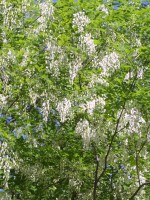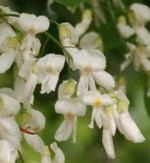 A rarely seen native of Southeastern United States, yellowwood is a medium-sized deciduous tree grown as an ornamental in diverse areas of the country for its fragrant flowers. In late spring to early summer white pea-like flowers are borne on long panicles ten to sixteen inches long resembling wisteria. Every two to three years the tree blooms heavily and is especially beautiful. The flowers are followed by 2½ to 4” long pods that turn brown in the fall. The bright green oval leaves are eight to ten inches long and pinnately compound with each leaflet two to three inches long. In fall the leaves are showy as they turn yellow, gold, and orange. In winter the branching pattern and attractive bark provide interest. Yellowwood makes an excellent specimen, lawn or patio tree and can be under-planted with other plants because of its deep root system. Once established it is tolerant of drought, city conditions, heat, cold, and wet soils. Unfortunately, it may take ten years to blooms and the small angles of branches make the tree susceptible to splitting.
A rarely seen native of Southeastern United States, yellowwood is a medium-sized deciduous tree grown as an ornamental in diverse areas of the country for its fragrant flowers. In late spring to early summer white pea-like flowers are borne on long panicles ten to sixteen inches long resembling wisteria. Every two to three years the tree blooms heavily and is especially beautiful. The flowers are followed by 2½ to 4” long pods that turn brown in the fall. The bright green oval leaves are eight to ten inches long and pinnately compound with each leaflet two to three inches long. In fall the leaves are showy as they turn yellow, gold, and orange. In winter the branching pattern and attractive bark provide interest. Yellowwood makes an excellent specimen, lawn or patio tree and can be under-planted with other plants because of its deep root system. Once established it is tolerant of drought, city conditions, heat, cold, and wet soils. Unfortunately, it may take ten years to blooms and the small angles of branches make the tree susceptible to splitting.
Type: Flowering deciduous tree
Outstanding Feature: Fragrant flowers
Form: Upright, spreading, vase-shaped, rounded crown
Growth Rate: Medium to slow
 Bloom: White pea-like, very fragrant flowers borne on panicles 10-16” long in late spring or early summer
Bloom: White pea-like, very fragrant flowers borne on panicles 10-16” long in late spring or early summer
Size: 30-45’ x 40-45’ W
Light: Full sun
Soil: Average, moist, well-drained; tolerates wet soils and alkalinity
Hardiness: Zones 4-9
Care: Prune in summer to avoid “bleeding”; protect from wind and winter sun.
Pests and Diseases: None of significance
Propagation: Seed; root cuttings in winter
Outstanding Selection: ‘Rosea’ (pink flowers).
